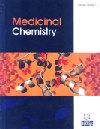通过大戟科植物(铅笔仙人掌)的 In silico、DFT、FMOs、Docking、分子动力学和 ADMET 研究头颈癌抑制剂的新方法
IF 2.6
4区 医学
Q3 CHEMISTRY, MEDICINAL
引用次数: 0
摘要
背景:头颈部癌症(HNC)在全球范围内呈上升趋势,危及生命,给发展中国家和发达国家的医疗保健系统造成了巨大压力。尽管有多种治疗方法可供选择,但治疗和控制头颈癌的成功率仍然令人沮丧。为了对抗 Epstein-Barr 病毒(EBV)阳性头颈癌细胞的侵袭性和耐药性,本研究探讨了铅笔仙人掌叶提取物(Euphorbia tirucalli)的潜力。研究目的本研究旨在从铅笔仙人掌(Euphorbia tirucalli)叶提取物中找出具有抑制 Epstein-Barr 病毒(EBV)阳性头颈癌细胞能力的潜在候选疗法。材料与方法:通过吸收、分布、代谢、排泄和毒性(ADMET)、量子力学(QM)计算、分子动力学(MD)分析、分子对接和分子动力学(MD)模拟等分子建模技术,分析了笔仙人掌叶中最重要的 13 种化学成分。利用物质活性谱预测(PASS)模型,我们在体外评估了这些化合物对爱泼斯坦巴氏病毒(EBV)阳性头颈癌细胞系的效力。通过量子化学计算和 HOMO-LUMO 分析,可以确定重要的分子特性,如化学势、电负性、硬度和软度。通过对药物动力学和 ADMET 的评估,这些药物的安全性和毒理学特性得到了更好的了解。这些测试表明,这些药物对人体没有肝毒性或致癌风险,可以安全使用。为了验证结合相互作用和复合物的稳定性,我们使用分子动力学模拟来揭示稳定的对接复合物。结果:分子对接分析发现配体(01)、(02)和(10)是强有力的竞争者,它们与 Epstein-Barr 病毒(EBV)阳性头颈癌细胞系有很强的结合亲和力。配体(01)、(02)和(10)不仅符合潜在的头颈癌新抑制剂的标准,而且其疗效优于目前美国食品及药物管理局批准的治疗方法。结论从铅笔仙人掌(Euphorbia tirucalli)叶片中分离出的三种植物化学物质 Taraxerol、euphol 和 ephorginol 已被确认为有效的抗癌剂,有可能成为新型头颈癌疗法的基础,尤其是那些针对这种疾病的 Epstein-Barr 病毒(EBV)表达过高亚型的疗法。针对头颈癌的有效个体化治疗方案还很遥远,但这项研究是向前迈出的重要一步,它可能会改变患者的生活,减轻这种疾病给全球带来的负担。本文章由计算机程序翻译,如有差异,请以英文原文为准。
New Approach as Inhibitor Against Head-Neck Cancer by In silico, DFT, FMOs, Docking, Molecular Dynamic, and ADMET of Euphorbia tirucalli (Pencil Cactus)
Background: Head and neck cancer (HNC) is on the rise worldwide, endangering lives and straining healthcare systems in both developing and developed nations. Despite the availability of a number of therapy options, the success rate for treating and controlling head and neck cancer remains dismal. To combat the aggressiveness and drug resistance of Epstein-Barr virus (EBV)-positive Head-Neck cancer cells, this study looks into the potential of Euphorbia tirucalli (pencil cactus) leaf extract. Objectives: The goal of this study is to identify prospective therapeutic candidates from the extract of Euphorbia tirucalli (pencil cactus) leaves, which have the ability to inhibit Epstein-Barr virus (EBV)-positive Head-Neck cancer cells. Materials and Methods: The thirteen most important chemical components found in Euphorbia tirucalli (pencil cactus) leaves were analyzed by means of molecular modeling techniques such as Absorption, Distribution, Metabolism, Excretion, and Toxicity (ADMET), Quantum Mechanics (QM) calculation, Molecular Dynamics (MD) profiling, molecular docking, and molecular dynamics (MD) simulations. Using the Prediction of Activity Spectra for Substances (PASS) model, we assess the potency of these compounds in vitro against an Epstein- Barr virus (EBV)-positive head-neck cancer cell line. Important molecular properties such as chemical potential, electronegativity, hardness, and softness can be determined with the use of quantum chemical calculations employing HOMO-LUMO analysis. These drugs' safety and toxicological characteristics are better understood thanks to assessments of their pharmacokinetics and ADMET. These tests show that there is no risk of hepatotoxicity or cancer in humans and that they are safe to use. In order to verify binding interactions and complex stability, molecular dynamics simulations are used to reveal stable docked complexes. Results: The molecular docking analysis identifies ligands (01), (02), and (10) as strong competitors, with strong binding affinity for the Epstein-Barr virus (EBV)-positive Head-Neck cancer cell line. Not only do the ligands (01), (02), and (10) match the criteria for a potential new inhibitor of head-neck cancer, but they also outperform the present FDA-approved treatment. Conclusion: Taraxerol, euphol, and ephorginol, three phytochemicals isolated from the leaves of the Euphorbia tirucalli (pencil cactus), have been identified as effective anti-cancer agents with the potential to serve as a foundation for novel head-neck cancer therapies, particularly those targeting the Epstein-Barr virus (EBV)-overexpressing subtype of this disease. An effective, individualized treatment plan for head-neck cancer is a long way off, but this study is a major step forward that could change the lives of patients and lessen the global burden of this disease.
求助全文
通过发布文献求助,成功后即可免费获取论文全文。
去求助
来源期刊

Medicinal Chemistry
医学-医药化学
CiteScore
4.30
自引率
4.30%
发文量
109
审稿时长
12 months
期刊介绍:
Aims & Scope
Medicinal Chemistry a peer-reviewed journal, aims to cover all the latest outstanding developments in medicinal chemistry and rational drug design. The journal publishes original research, mini-review articles and guest edited thematic issues covering recent research and developments in the field. Articles are published rapidly by taking full advantage of Internet technology for both the submission and peer review of manuscripts. Medicinal Chemistry is an essential journal for all involved in drug design and discovery.
 求助内容:
求助内容: 应助结果提醒方式:
应助结果提醒方式:


